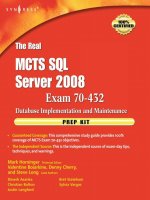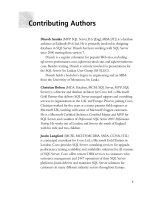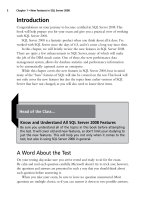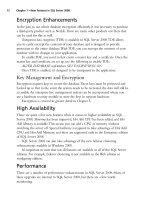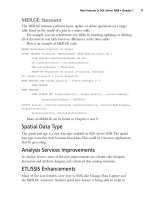The Real MTCS SQL Server 2008 Exam 70/432 Prep Kit- P16 pps
Bạn đang xem bản rút gọn của tài liệu. Xem và tải ngay bản đầy đủ của tài liệu tại đây (126.86 KB, 5 trang )
Operating System
Requirements
Enterprise
x64
Enterprise
IA64
Standard
x64
Standard x64
for Small
Business
Enterprise
x32
Standard
x32
Windows XP
Professional x64
√
Windows Server 2003
SP2 64-bit x64
Standard
√ - WOW64 √ - WOW64
Windows Server 2003
SP2 64-bit x64 Data
Center
√ - WOW64 √ - WOW64
Windows Server 2003
SP2 64-bit x64
Enterprise
√ - WOW64 √ - WOW64
Windows Server 2003
SP2 64-bit Itanium
Data Center
√ - WOW64
Windows Server 2003
SP2 64-bit Itanium
Enterprise
√ - WOW64
Windows Server 2008
x64 Web
√ - WOW64
Windows Server 2008
64-bit x64 Standard
√ √ - WOW64
Table 2.9 Operating System Requirements for SQL Server 2008 Editions
Continued
Operating System
Requirements
Enterprise
x64
Enterprise
IA64
Standard
x64
Standard x64
for Small
Business
Enterprise
x32
Standard
x32
Windows Server 2008
64-bit x64 Standard
without Hyper-V
√ √ - WOW64
Windows Server 2008
64-bit x64 Data
Center
√ √ - WOW64
Windows Server 2008
64-bit x64 Data
Center without
Hyper-V
√ √ - WOW64
Windows Server 2008
64-bit x64 Enterprise
√ - WOW64
Windows Server 2008
64-bit x64 Enterprise
without Hyper-V1
√ - WOW64
Windows Server 2008
64-bit Itanium
√ - WOW64
Windows Vista
Ultimate x64
√
Table 2.9 Continued. Operating System Requirements for SQL Server 2008 Editions
Windows Vista
Enterprise x64
√
Windows Vista
Business x64
√
Windows Small
Business Server 2008
√
Windows Server 2008
for Windows Essential
Server Solutions
√
Windows Server 2008
for Windows Essential
Server Solutions
without Hyper-V
√
60 Chapter2•InstallingSQLServer2008
No T e
Enterprise IA64 is not available in the localized versions of Italian, Spanish,
Portuguese (Brazilian), or Russian. WOW64 indicates that the Management
Tools are supported in WOW64, a feature of 64-bit editions of Windows
that enables 32-bit applications to run natively in 32-bit mode.
Software Requirements
As part of the SQL Server 2008 software installation wizard, a validation process
performed by System Configuration Check routinely scans the server for conditions
that might block the setup or installation process.
Pre-installing .NET Framework 3.5, Microsoft Installer 4.5, and Windows
PowerShell 1.0 will minimize or avoid a system reboot or errors on installation.
All of these can be downloaded from the Microsoft download site, www.microsoft.
com/downloads.
Microsoft Internet Explorer 6 SP1 or later will be required for the installation
process. Internet Explorer is required by SSMS, BIDS, Reporting Services’ Report
Designer, HTML Help, and Microsoft Management Console (MMC).
Establishing Service Accounts
The selection of the installation account and the service accounts is part of the
installation planning. The most common scenarios for the installation account
privileges include:
For local installations, the installation account must have Administrator
privileges.
For installs where the installation software is on a remote share, the
installation account must be a domain account with Administrator
privileges, and read and execute permissions on the remote share.
For installations on clusters, the installation account must be a local
administrator on the cluster with permissions to log in as a service
on the cluster.
Each service in SQL Server must have an account configured during installation.
Service accounts used to start and run SQL Server can be built-in system accounts,
local user accounts, or domain user accounts. Microsoft recommends that service
accounts be configured such that SQL Server services are granted the minimum
permissions to complete their tasks. SQL Server 2008 service accounts are described
in the following list:
InstallingSQLServer2008•Chapter2 61
Domain user account If the service must interact with network
services, access domain resources such as file shares, or use linked server
connections to other computers running SQL Server, you might use
a minimally privileged domain account. Many server-to-server activities
require a domain user account. The domain accounts must exist prior
to the installation process, unlike when using local accounts.
Local user account A local user account without Windows Administrator
permissions is recommended if the computer is not part of a domain.
Local service account An account that is a built-in account (also known
as an “NT AUTHORITY\Local Service account”) and has the same level
of access to resources and objects as members of the Users group. These
restricted privileges help safeguard the system if individual services or
processes are compromised, but they are not supported for SQL Server
or SQL Server Agent services.
Network service account (“NT AUTHORITY\NetworkService”)
The network service account is a built-in account that has more access
to resources and objects than members of the Users group. Services that
run as the network service account access network resources by using
the credentials of the computer account.
Local system account (“NT AUTHORITY\System”) A very high-privi-
leged built-in account that has extensive privileges on the local system and
acts as the computer on the network.
In addition to having user accounts, every service has three possible startup
states that users can control:
Disabled The service is installed but not currently running.
Manual The service is installed, but will start only when another service
or application needs its functionality.
Automatic The service is automatically started by the operating system.
The administrator account used during the installation process enables the setup
process to create local service user groups for the different SQL Server services, and
assigns the service account or service SIDs to the appropriate local service group.
The service user groups help secure the SQL Server files, as well as simplify the
process of granting permissions required by the service.
Table 2.10 summarizes the account types that can be used for each SQL
Service, as well as user groups and permissions created by the SQL Server installer.
